There was much rain through the night, and it was still pouring when we rose. Rex zig-zagged quickly to the toilet block, not unlike a bee on ecstasy, but to no avail. He was getting a little worried; he'd had no success for three days. I advised plenty of prunes, but he can't stand fruit.
Weather charts indicated that sunny periods should appear in the afternoon, so when we reached the point when we could see through the gloom, we slipped our lines, and headed to the nearby sluis that would give us access to the Markermeer.
We tied up in the holding area, and quickly dashed to help a large traditional Dutch botter. The wind was playing havoc with it, and its stern was skimming across the holding area. With much brute force we managed to get the vessel moored. With no time to spare we hurtled back along the staging to assist another Dutch yacht moor. Renditions of , "Dank u wel!", and "Graag gedaan!" were flying about as the Dutch sailors showed their appreciation for our efforts.
In a short while we entered the sluis. A large commercial barge entered a parallel sluis alongside, announcing its presence with much crashing and scraping as the captain misjudged his line and bounced off the sides as he screeched in. For added extra entertainment, a tall training ship entered our sluis behind us. All good fun!
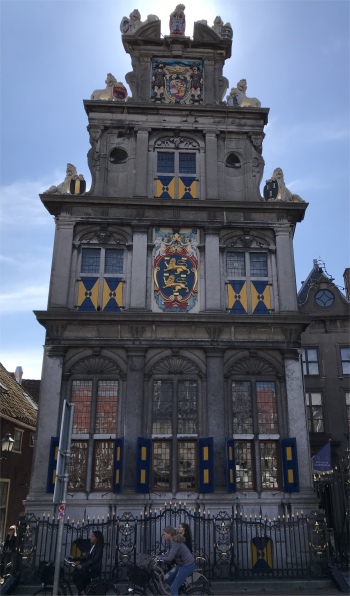
West Frisian Museum
|
Once we were in the Markermeer, we ploughed into a Force 3/4 right on the nose, through choppy waters. Not many vessels were sailing today. The exceedingly tall telecoms 161m tower at Lelystad was clearly visible, even though it was 13.6 miles away. Ahead breaks in the clouds showed promise of better weather to come, and after an hour or so we caught up with some sunshine.
We did pass some weed on the way, as predicted by our temporary German neighbour, but it didn't appear to be serious.
After an uneventful journey, we glided into Grashaven marina in Hoorn, and once moored safely in a box, I left Rex to recover while I hiked into town to purchase presents for my grandchildren.
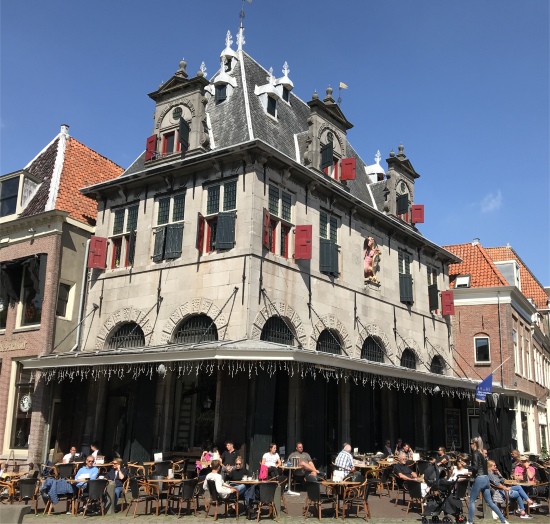
Waag
|
Sometime around 1300, farmers and fishermen founded the tiny village of Hoorn, strategically located in a bend on the Westfrisian coast where the Gouw River met the old Zuiderzee, now called Ijsselmeer. By 1357 the place was already of such importance that it was given city-rights by Count Willem V. In 1426 walls were built to protect the city. The walls included four gates, of which only one survives today. As more merchants and bargemen moved into the conurbation, the town slowly grew larger and larger. In 1573 it became the capital of West-Frisia when, after a fierce battle right on its doorstep, a local fleet under the leadership of Cornelis Dirksz had defeated a large Spanish fleet under the command of the Count of Bossu. This was a turning point in the war of independence against Spain.

Statenlogement
|
Ten years later the city minted its own coins, the Westfrisian Rijksdaalder. For Hoorn and its citizens a period of great prosperity had begun and the city now put all its attention to the sea. The harbour was largely extended and business with the Atlantic coast, the Mediterranean, the Baltic States and the Far East bloomed. Hoorn soon became one of the six founding cities of the Vereenigde Oostindische Compagnie (VOC), the world's first multinational company. Ships loaded with spices, tea, coffee, sugar, wheat, silk, cotton, copper and indigo returned from all over the world, as far as South-America and the Arctic Ocean, where whales were hunted for oil. Around 1650, stagnation set in and a century later the city fell into decline. By the end of the French occupation (1795-1813) the population had dropped to a mere 7,500 and the once proud city looked like a disorganised village. But slowly it recovered and today the city booms again with a population of around 70,000. Many of the old buildings have survived and others were restored to their former splendour.
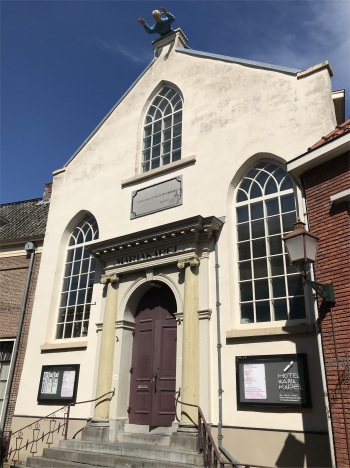
Hotel Maria Kapel
|
As I headed into town, I walked through the large square, Roode Steen (Red Stone). Taking pride of place on the square was the imposing building of the West Frisian Museum, a stately monument with its distinctive, richly decorated fašade, housed in the States College since 1881. It contained the original management offices and meeting building of the Executive Committed Councils of West Friesland and Holland's Northern Quarter, which met here several times a year. This marked Hoorn's main square as a place of trade and events that played a key role in the Hoorn existence since 1632.
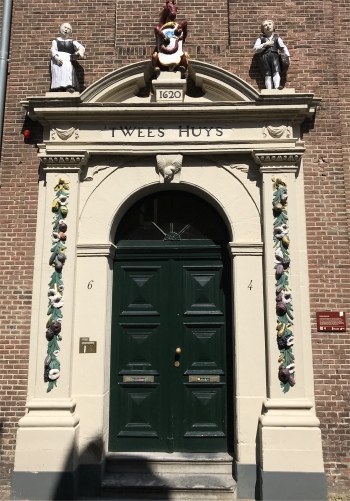
Twees Huys (Orphanage)
|
In the square stood a statue of Jan Pieterszoon Coen (1587- 1629), merchant, Director-General and Governor-General of the Dutch East India Company (VOC). He was the architect of the successful trading empire of the VOC in Asia, and founded Batavia, now Jakarta.
Coen was hailed as a forceful and visionary administrator. But he was also criticised for the violent means by which he built up trade monopolies in the East Indies. In 1621 Coen led a punitive expedition against one of the Banda Islands, because the local population was selling nutmeg to the English despite a VOC ban. Thousands of Bandanese lost their lives during the assault, and the survivors were deported to Batavia.

Grote Kerk
|
By the end of the 19th century, Coen had acquired the status of a national hero, and was honoured with a statue in his hometown. However, the statue is controversial. According to critics, Coen's violent trade policy in the East Indian archipelago does not deserve to be honoured.
On one corner of the square stood the inevitable Waag. From the very beginning of Hoorn, the Roode Steen (Red Stone) was the centre of commerce, government and law, and today the Roode Steen is still considered the main square for all kinds of social activities. Here the Waag played a prominent role, especially as regards trade in agricultural products which were imported from the West Frieze hinterland. The weighing was carried out to establish the correct weight, and hence determined the level of payment of an excise duty (tax), which benefited the magistrate of the area. Initially this was Holland van de Graaf. By 1602 the Waag was owned by the city.
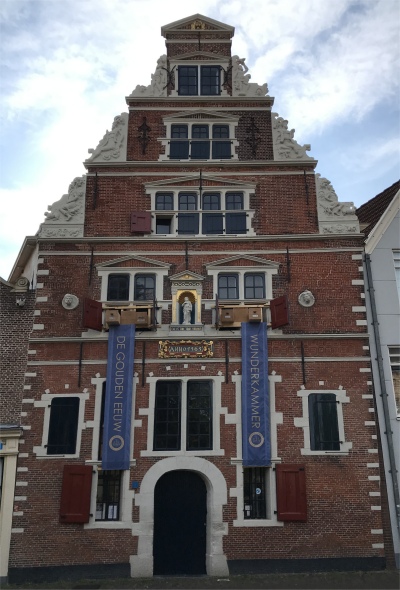
St. Jansgasthuis
|
I aimed myself to where I thought the shops were, passing the Statenlogement (State Lodgings) with its beautiful double step-gable from the period of the Dutch Renaissance. The building was built in 1613 and on its fašade, you can find the city arms of Medemblik, Edam, Alkmaar, Hoorn, Enkhuizen, Monnickendam and Purmerend. The 'Statenlogement' was used as a hotel for very important guests who participated in meetings of the Board of the Noorderkwartier and West-Friesland. Till 1977, it served as the town hall. Nowadays, this beautiful building hosts most marriages.
Moving on, I discovered again the Hotel Maria Kapel, with its peculiar figure lying horizontally above the gable. It is located in an early 16th century chapel, surrounded by a semi-private courtyard. This beautifully, tranquil and spacious working environment offers the artists-in-residence a unique space for reflection, experimentation and production, as well as exhibition space and a cinema for contemporary visual art in the city centre.
Close by lay the Kerkplein, literally Church Square, where the Grote Kerk is located. The Grote Kerk was built in 1881 and has a height of 60 meters.
Situated on the Kerkplein was the St. Jansgasthuis, one of the first hospitals in Hoorn. As a monastery, it was the only place that accommodated pilgrims and travellers. That's where the name Gasthuis, literally translated Guest House, comes from. The rooms which were not occupied by travellers where used to accommodate the sick and the weak. Over the years, St. Jansgasthuis became increasingly filled to a point where it was difficult to still offer proper health care.

Student Celebrations
|
In the evening, we walked to the Roode Steen, to enjoy a beer outside the Waag before our evening meal. As we basked in the sun, we watched a few folk gather outside the pub on the square named The Eighties. A few more joined including some smartly dressed young men. We thought there might be a wedding reception or the likes. Eagle eyed Rex, from his crow's nest, spotted a red carpet leading to the pub's front door. More and more folk gathered to form an appreciable crowd. Next to roll up was a very smart car, out of which a couple of well-dressed young women alighted igniting loud applause. "Are they the Dutch equivalent of the Spice Girls?" Rex mused. More posh cars turned up, and yet more glamourous women alighted to yet more cheers. Cameras worked overtime, and half the people sitting outside the Waag got up and joined the crowd. My curiosity got the better of me, and I asked a couple sitting behind us what the happening was. "They are all students who have just passed their exams," he informed me. A long convoy of vehicles streamed by: cars, stretch limos, a tractor, and then a stream of motorbikes all competing to see who could make most noise and burn most rubber. The precession continued with no end, much to the delight of a police car and van trying to get down the street with lights flashing.
We grew tired of the spectacle and sought refuge in a restaurant a street away. Here we enjoyed different ales and a satisfying meal. Two groups sat nearby, one group of four Dutchmen, and the other five Germans, perhaps all sailors seeking shelter from the din in the square.








